Check answers here:
Modules 4 – 7: Ethernet Concepts Exam Answers
Quiz-summary
0 of 80 questions completed
Questions:
- 1
- 2
- 3
- 4
- 5
- 6
- 7
- 8
- 9
- 10
- 11
- 12
- 13
- 14
- 15
- 16
- 17
- 18
- 19
- 20
- 21
- 22
- 23
- 24
- 25
- 26
- 27
- 28
- 29
- 30
- 31
- 32
- 33
- 34
- 35
- 36
- 37
- 38
- 39
- 40
- 41
- 42
- 43
- 44
- 45
- 46
- 47
- 48
- 49
- 50
- 51
- 52
- 53
- 54
- 55
- 56
- 57
- 58
- 59
- 60
- 61
- 62
- 63
- 64
- 65
- 66
- 67
- 68
- 69
- 70
- 71
- 72
- 73
- 74
- 75
- 76
- 77
- 78
- 79
- 80
Information
CCNA 1 v7 Modules 4 – 7: Ethernet Concepts - Test online
You have already completed the quiz before. Hence you can not start it again.
Quiz is loading...
You must sign in or sign up to start the quiz.
You have to finish following quiz, to start this quiz:
Results
0 of 80 questions answered correctly
Your time:
Time has elapsed
You have reached 0 of 0 points, (0)
| Average score |
|
| Your score |
|
Categories
- Not categorized 0%
- 1
- 2
- 3
- 4
- 5
- 6
- 7
- 8
- 9
- 10
- 11
- 12
- 13
- 14
- 15
- 16
- 17
- 18
- 19
- 20
- 21
- 22
- 23
- 24
- 25
- 26
- 27
- 28
- 29
- 30
- 31
- 32
- 33
- 34
- 35
- 36
- 37
- 38
- 39
- 40
- 41
- 42
- 43
- 44
- 45
- 46
- 47
- 48
- 49
- 50
- 51
- 52
- 53
- 54
- 55
- 56
- 57
- 58
- 59
- 60
- 61
- 62
- 63
- 64
- 65
- 66
- 67
- 68
- 69
- 70
- 71
- 72
- 73
- 74
- 75
- 76
- 77
- 78
- 79
- 80
- Answered
- Review
-
Question 1 of 80
1. Question
1 pointsWhat is the purpose of the OSI physical layer?Correct
Incorrect
-
Question 2 of 80
2. Question
1 pointsWhy are two strands of fiber used for a single fiber optic connection?Correct
Incorrect
-
Question 3 of 80
3. Question
1 pointsWhich characteristic describes crosstalk?Correct
Incorrect
-
Question 4 of 80
4. Question
1 pointsWhich procedure is used to reduce the effect of crosstalk in copper cables?Correct
Incorrect
-
Question 5 of 80
5. Question
1 pointsMatch the situation with the appropriate use of network media.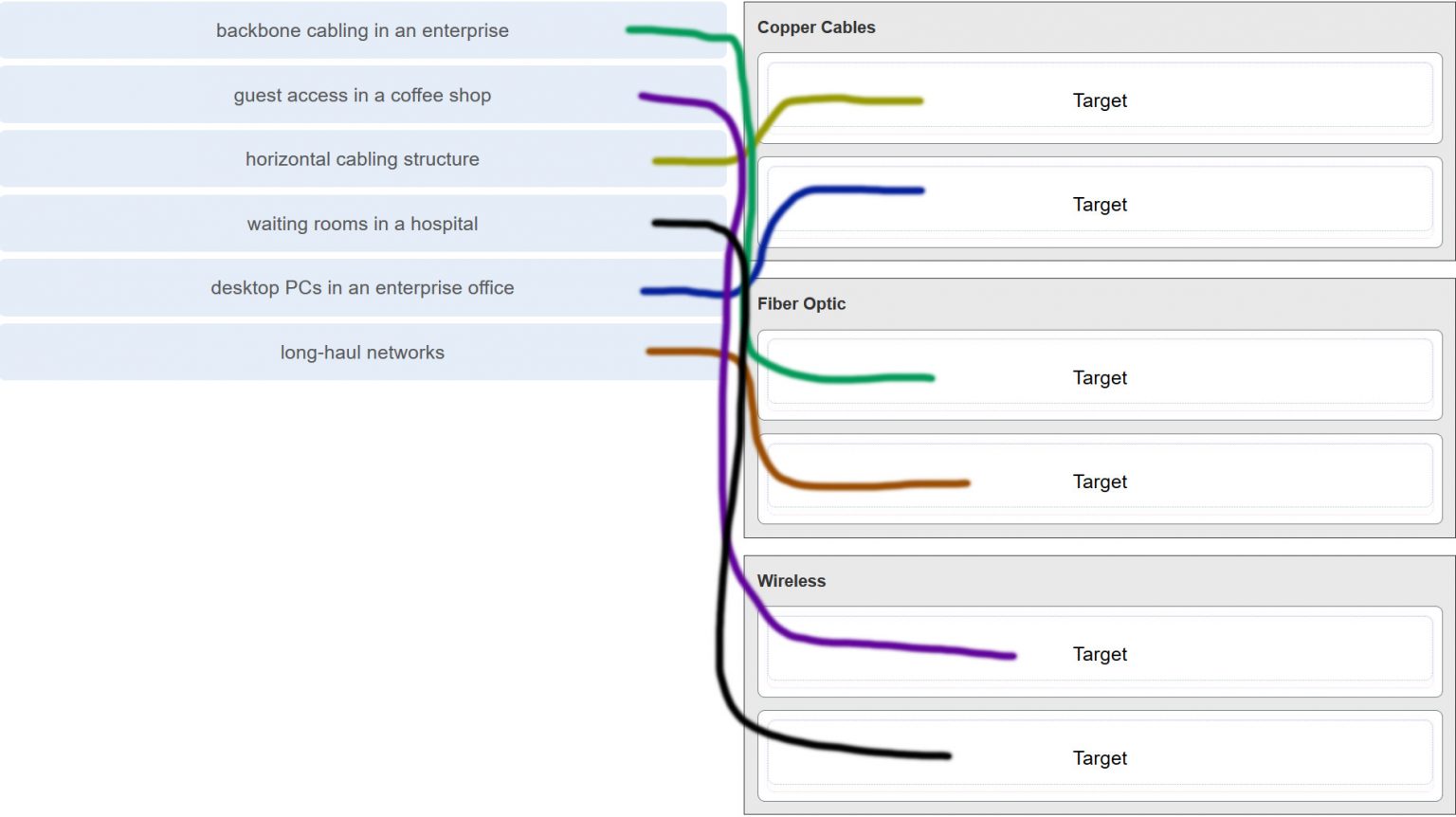 Correct
Correct
Incorrect
-
Question 6 of 80
6. Question
1 pointsA network administrator is measuring the transfer of bits across the company backbone for a mission critical financial application. The administrator notices that the network throughput appears lower than the bandwidth expected. Which three factors could influence the differences in throughput? (Choose three.)Correct
Incorrect
Hint
Throughput usually does not match the specified bandwidth of physical links due to multiple factors. These factors include, the amount of traffic, type of traffic, and latency created by the network devices the data has to cross. -
Question 7 of 80
7. Question
1 pointsWhat are two characteristics of fiber-optic cable? (Choose two.)Correct
Incorrect
Hint
Fiber-optic cabling supports higher bandwidth than UTP for longer distances. Fiber is immune to EMI and RFI, but costs more, requires more skill to install, and requires more safety precautions. -
Question 8 of 80
8. Question
1 pointsWhat is a primary role of the Physical layer in transmitting data on the network?Correct
Incorrect
Hint
The OSI physical layer provides the means to transport the bits that make up a frame across the network media. This layer accepts a complete frame from the data link layer and encodes it as a series of signals that are transmitted to the local media. -
Question 9 of 80
9. Question
1 pointsWith the use of unshielded twisted-pair copper wire in a network, what causes crosstalk within the cable pairs?Correct
Incorrect
Hint
Crosstalk is a type of noise, or interference that occurs when signal transmission on one wire interferes with another wire. When current flows through a wire a magnetic field is produced. The produced magnetic field will interface the signal carried in the adjacent wire. -
Question 10 of 80
10. Question
1 pointsRefer to the graphic. What type of cabling is shown?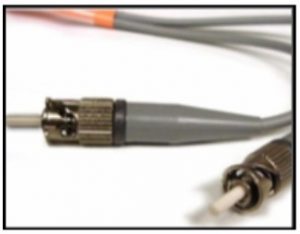 Correct
Correct
Incorrect
Hint
Network cabling include different types of cables:- UTP cable consists of four pairs of color-coded wires that have been twisted together and then encased in a flexible plastic sheath.
- STP cable uses four pairs of wires, each wrapped in a foil shield, which are then wrapped in an overall metallic braid or foil.
- Coaxial cable uses a copper conductor and a layer of flexible plastic insulation surrounds the copper conductor.
- Fiber cable is a flexible, extremely thin, transparent strand of glass surrounded by plastic insulation.
-
Question 11 of 80
11. Question
1 pointsIn addition to the cable length, what two factors could interfere with the communication carried over UTP cables? (Choose two.)Correct
Incorrect
Hint
Copper media is widely used in network communications. However, copper media is limited by distance and signal interference. Data is transmitted on copper cables as electrical pulses. The electrical pulses are susceptible to interference from two sources:- Electromagnetic interference (EMI) or radio frequency interference (RFI) – EMI and RFI signals can distort and corrupt the data signals being carried by copper media.
- Crosstalk – Crosstalk is a disturbance caused by the electric or magnetic fields of a signal on one wire interfering with the signal in an adjacent wire.
-
Question 12 of 80
12. Question
1 pointsRefer to the graphic. What type of cabling is shown?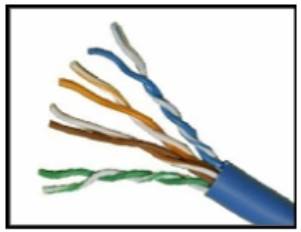 Correct
Correct
Incorrect
-
Question 13 of 80
13. Question
1 pointsWhich two devices commonly affect wireless networks? (Choose two.)Correct
Incorrect
Hint
Radio Frequency Interference (RFI) is the interference that is caused by radio transmitters and other devices that are transmitting in the same frequency. -
Question 14 of 80
14. Question
1 pointsWhich two statements describe the services provided by the data link layer? (Choose two.)Correct
Incorrect
Hint
The data link layer is divided into two sub layers, namely Logical Link Control (LLC) and Media Access Control (MAC). LLC forms a frame from the network layer PDU into a format that conforms to the requirements of the network interface and media. A network layer PDU might be for IPv4 or IPv6. The MAC sub layer defines the media access processes performed by the hardware. It manages the frame access to the network media according to the physical signaling requirements (copper cable, fiber optic, wireless, etc.) -
Question 15 of 80
15. Question
1 pointsWhat is the function of the CRC value that is found in the FCS field of a frame?Correct
Incorrect
-
Question 16 of 80
16. Question
1 pointsWhat is contained in the trailer of a data-link frame?Correct
Incorrect
-
Question 17 of 80
17. Question
1 pointsWhich statement describes a characteristic of the frame header fields of the data link layer?Correct
Incorrect
Hint
All data link layer protocols encapsulate the Layer 3 PDU within the data field of the frame. However, the structure of the frame and the fields that are contained in the header vary according to the protocol. Different data link layer protocols may use different fields, like priority/quality of service, logical connection control, physical link control, flow control, and congestion control. -
Question 18 of 80
18. Question
1 pointsA network team is comparing physical WAN topologies for connecting remote sites to a headquarters building. Which topology provides high availability and connects some, but not all, remote sites?Correct
Incorrect
Hint
Partial mesh topologies provide high availability by interconnecting multiple remote sites, but do not require a connection between all remote sites. A mesh topology requires point-to-point links with every system being connected to every other system. A point-to-point topology is where each device is connected to one other device. A hub and spoke uses a central device in a star topology that connects to other point-to-point devices. -
Question 19 of 80
19. Question
1 pointsWhich two fields or features does Ethernet examine to determine if a received frame is passed to the data link layer or discarded by the NIC? (Choose two.)Correct
Incorrect
-
Question 20 of 80
20. Question
1 pointsWhich media communication type does not require media arbitration in the data link layer?Correct
Incorrect
Hint
Half-duplex communication occurs when both devices can both transmit and receive on the medium but cannot do so simultaneously. Full-duplex communication occurs when both devices can transmit and receive on the medium at the same time and therefore does not require media arbitration. Half-duplex communication is typically contention-based, whereas controlled (deterministic) access is applied in technologies where devices take turns to access the medium. -
Question 21 of 80
21. Question
1 pointsWhich statement describes an extended star topology?Correct
Incorrect
Hint
In an extended star topology, central intermediate devices interconnect other star topologies. -
Question 22 of 80
22. Question
1 pointsWhat is a characteristic of the LLC sublayer?Correct
Incorrect
-
Question 23 of 80
23. Question
1 pointsWhat are three ways that media access control is used in networking? (Choose three.)Correct
Incorrect
-
Question 24 of 80
24. Question
1 pointsDuring the encapsulation process, what occurs at the data link layer for a PC connected to an Ethernet network?Correct
Incorrect
Hint
The Ethernet frame includes the source and destination physical address. The trailer includes a CRC value in the Frame Check Sequence field to allow the receiving device to determine if the frame has been changed (has errors) during the transmission. -
Question 25 of 80
25. Question
1 pointsWhat three items are contained in an Ethernet header and trailer? (Choose three.)Correct
Incorrect
Hint
Layer 2 headers contain the following:- Frame start and stop indicator flags at the beginning and end of a frame
- Addressing – for Ethernet networks this part of the header contains source and destination MAC addresses
- Type field to indicate what Layer 3 protocol is being used
- Error detection to determine if the frame arrived without error
-
Question 26 of 80
26. Question
1 pointsWhat type of communication rule would best describe CSMA/CD?Correct
Incorrect
Hint
Carrier sense multiple access collision detection (CSMA/CD) is the access method used with Ethernet. The access method rule of communication dictates how a network device is able to place a signal on the carrier. CSMA/CD dictates those rules on an Ethernet network and CSMA/CA dictates those rules on an 802.11 wireless LAN. -
Question 27 of 80
27. Question
1 pointsWhich three basic parts are common to all frame types supported by the data link layer? (Choose three.)Correct
Incorrect
Hint
The data link protocol is responsible for NIC-to-NIC communications within the same network. Although there are many different data link layer protocols that describe data link layer frames, each frame type has three basic parts:- Header
- Data
- Trailer
-
Question 28 of 80
28. Question
1 pointsWhich statement is true about the CSMA/CD access method that is used in Ethernet?Correct
Incorrect
-
Question 29 of 80
29. Question
1 pointsWhat is the auto-MDIX feature on a switch?Correct
Incorrect
Hint
The auto-MDIX enables a switch to use a crossover or a straight-through Ethernet cable to connect to a device regardless of the device on the other end of the connection. -
Question 30 of 80
30. Question
1 pointsRefer to the exhibit. What is the destination MAC address of the Ethernet frame as it leaves the web server if the final destination is PC1?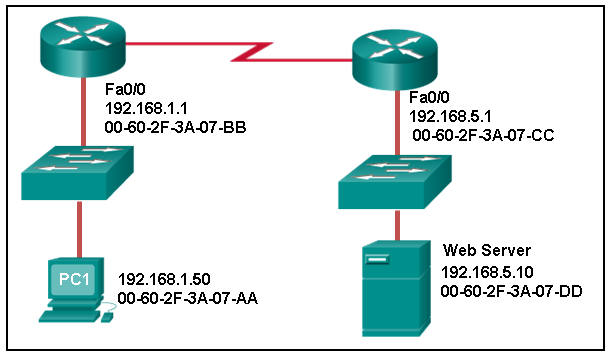 Correct
Correct
Incorrect
Hint
The destination MAC address is used for local delivery of Ethernet frames. The MAC (Layer 2) address changes at each network segment along the path. As the frame leaves the web server, it will be delivered by using the MAC address of the default gateway. -
Question 31 of 80
31. Question
1 pointsA Layer 2 switch is used to switch incoming frames from a 1000BASE-T port to a port connected to a 100Base-T network. Which method of memory buffering would work best for this task?Correct
Incorrect
Hint
With shared memory buffering, the number of frames stored in the buffer is restricted only by the of the entire memory buffer and not limited to a single port buffer. This permits larger frames to be transmitted with fewer dropped frames. This is important to asymmetric switching, which applies to this scenario, where frames are being exchanged between ports of different rates. With port-based memory buffering, frames are stored in queues that are linked to specific incoming and outgoing ports making it possible for a single frame to delay the transmission of all the frames in memory because of a busy destination port. Level 1 cache is memory used in a CPU. Fixed configuration refers to the port arrangement in switch hardware. -
Question 32 of 80
32. Question
1 pointsWhat are two examples of the cut-through switching method? (Choose two.)Correct
Incorrect
Hint
Store-and forward switching accepts the entire frame and performs error checking using CRC before forwarding the frame. Store-and-forward is often required for QOS analysis. Fast-forward and fragment-free are both variations of the cut-through switching method where only part of the frame is received before the switch begins to forward it. -
Question 33 of 80
33. Question
1 pointsWhich frame forwarding method receives the entire frame and performs a CRC check to detect errors before forwarding the frame?Correct
Incorrect
Hint
Fast-forward and fragment-free switching are variations of cut-through switching, which begins to forward the frame before the entire frame is received. -
Question 34 of 80
34. Question
1 pointsWhat is the purpose of the FCS field in a frame?Correct
Incorrect
Hint
The FCS field in a frame is used to detect any errors in the transmission and receipt of a frame. This is done by comparing the CRC value within the frame against a computed CRC value of the frame. If the two values do not match, then the frame is discarded. -
Question 35 of 80
35. Question
1 pointsWhich switching method has the lowest level of latency?Correct
Incorrect
Hint
Fast-forward switching begins to forward a frame after reading the destination MAC address, resulting in the lowest latency. Fragment-free reads the first 64 bytes before forwarding. Store-and-forward has the highest latency because it reads the entire frame before beginning to forward it. Both fragment-free and fast-forward are types of cut-through switching. -
Question 36 of 80
36. Question
1 pointsA network administrator is connecting two modern switches using a straight-through cable. The switches are new and have never been configured. Which three statements are correct about the final result of the connection? (Choose three.)Correct
Incorrect
Hint
Modern switches can negotiate to work in full-duplex mode if both switches are capable. They will negotiate to work using the fastest possible speed and the auto-MDIX feature is enabled by default, so a cable change is not needed. -
Question 37 of 80
37. Question
1 pointsWhich advantage does the store-and-forward switching method have compared with the cut-through switching method?Correct
Incorrect
Hint
A switch using the store-and-forward switching method performs an error check on an incoming frame by comparing the FCS value against its own FCS calculations after the entire frame is received. In comparison, a switch using the cut-through switching method makes quick forwarding decisions and starts the forwarding process without waiting for the entire frame to be received. Thus a switch using cut-through switching may send invalid frames to the network. The performance of store-and-forward switching is slower compared to cut-through switching performance. Collision detection is monitored by the sending device. Store-and-forward switching does not use IPv4 Layer 3 and 4 information for its forwarding decisions. -
Question 38 of 80
38. Question
1 pointsWhen the store-and-forward method of switching is in use, what part of the Ethernet frame is used to perform an error check?Correct
Incorrect
Hint
The cyclic redundancy check (CRC) part of the trailer is used to determine if the frame has been modified during transit. If the integrity of the frame is verified, the frame is forwarded. If the integrity of the frame cannot be verified, then the frame is dropped. -
Question 39 of 80
39. Question
1 pointsWhich switching method uses the CRC value in a frame?Correct
Incorrect
Hint
When the store-and-forward switching method is used, the switch receives the complete frame before forwarding it on to the destination. The cyclic redundancy check (CRC) part of the trailer is used to determine if the frame has been modified during transit. In contrast, a cut-through switch forwards the frame once the destination Layer 2 address is read. Two types of cut-through switching methods are fast-forward and fragment-free. -
Question 40 of 80
40. Question
1 pointsWhat are two actions performed by a Cisco switch? (Choose two.)Correct
Incorrect
Hint
Important actions that a switch performs are as follows:- When a frame comes in, the switch examines the Layer 2 source address to build and maintain the Layer 2 MAC address table.
- It examines the Layer 2 destination address to determine how to forward the frame. When the destination address is in the MAC address table, then the frame is sent out a particular port. When the address is unknown, the frame is sent to all ports that have devices connected to that network.
-
Question 41 of 80
41. Question
1 pointsWhich two statements describe features or functions of the logical link control sublayer in Ethernet standards? (Choose two.)Correct
Incorrect
Hint
Logical link control is implemented in software and enables the data link layer to communicate with the upper layers of the protocol suite. Logical link control is specified in the IEEE 802.2 standard. IEEE 802.3 is a suite of standards that define the different Ethernet types. The MAC (Media Access Control) sublayer is responsible for the placement and retrieval of frames on and off the media. The MAC sublayer is also responsible for adding a header and a trailer to the network layer protocol data unit (PDU). -
Question 42 of 80
42. Question
1 pointsWhat is the auto-MDIX feature?Correct
Incorrect
Hint
The auto-MDIX feature allows the device to configure its network port according to the cable type that is used (straight-through or crossover) and the type of device that is connected to that port. When a port of a switch is configured with auto-MDIX, this switch can be connected to another switch by the use of either a straight-through cable or a crossover cable. -
Question 43 of 80
43. Question
1 pointsWhat is one advantage of using the cut-through switching method instead of the store-and-forward switching method?Correct
Incorrect
Hint
Cut-through switching provides lower latency switching for high-performance computing (HPC) applications. Cut-through switching allows more invalid frames to cross the network than store-and-forward switching. The cut-through switching method can make a forwarding decision as soon as it looks up the destination MAC address of the frame. -
Question 44 of 80
44. Question
1 pointsWhich is a multicast MAC address?Correct
Incorrect
-
Question 45 of 80
45. Question
1 pointsRefer to the exhibit. What is wrong with the displayed termination?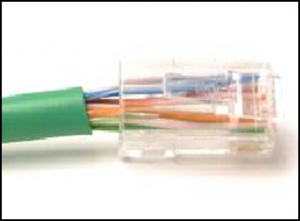 Correct
Correct
Incorrect
Hint
When a cable to an RJ-45 connector is terminated, it is important to ensure that the untwisted wires are not too long and that the flexible plastic sheath surrounding the wires is crimped down and not the bare wires. None of the colored wires should be visible from the bottom of the jack. -
Question 46 of 80
46. Question
1 pointsRefer to the exhibit. The PC is connected to the console port of the switch. All the other connections are made through FastEthernet links. Which types of UTP cables can be used to connect the devices? Correct
Correct
Incorrect
Hint
A straight-through cable is commonly used to interconnect a host to a switch and a switch to a router. A crossover cable is used to interconnect similar devices together like switch to a switch, a host to a host, or a router to a router. If a switch has the MDIX capability, a crossover could be used to connect the switch to the router; however, that option is not available. A rollover cable is used to connect to a router or switch console port. -
Question 47 of 80
47. Question
1 pointsOpen the PT Activity. Perform the tasks in the activity instructions and then answer the question. Which port does Switch0 use to send frames to the host with the IPv4 address 10.1.1.5?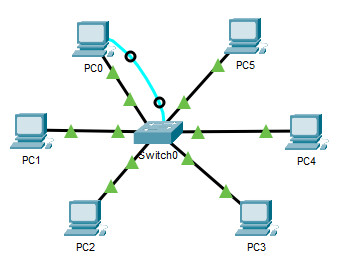 Correct
Correct
Incorrect
Hint
Issuing the command ipconfig /all from the PC0 command prompt displays the IPv4 address and MAC address. When the IPv4 address 10.1.1.5 is pinged from PC0, the switch stores the source MAC address (from PC0) along with the port to which PC0 is connected. When the destination reply is received, the switch takes the destination MAC address and compares to MAC addresses stored in the MAC address table. Issuing the show mac-address-table on the PC0 Terminal application displays two dynamic MAC address entries. The MAC address and port entry that does not belong to PC0 must be the MAC address and port of the destination with the IPv4 address 10.1.1.5. -
Question 48 of 80
48. Question
1 pointsWhat does the term “attenuation” mean in data communication?Correct
Incorrect
Hint
Data is transmitted on copper cables as electrical pulses. A detector in the network interface of a destination device must receive a signal that can be successfully decoded to match the signal sent. However, the farther the signal travels, the more it deteriorates. This is referred to as signal attenuation. -
Question 49 of 80
49. Question
1 pointsWhat makes fiber preferable to copper cabling for interconnecting buildings? (Choose three.)Correct
Incorrect
Hint
Optical fiber cable transmits data over longer distances and at higher bandwidths than any other networking media. Unlike copper wires, fiber-optic cable can transmit signals with less attenuation and is completely immune to EMI and RFI. -
Question 50 of 80
50. Question
1 pointsWhat OSI physical layer term describes the process by which one wave modifies another wave?Correct
Incorrect
-
Question 51 of 80
51. Question
1 pointsWhat OSI physical layer term describes the capacity at which a medium can carry data?Correct
Incorrect
-
Question 52 of 80
52. Question
1 pointsWhat OSI physical layer term describes the capacity at which a medium can carry data?Correct
Incorrect
-
Question 53 of 80
53. Question
1 pointsWhat OSI physical layer term describes the measure of the transfer of bits across a medium over a given period of time?Correct
Incorrect
-
Question 54 of 80
54. Question
1 pointsWhat OSI physical layer term describes the amount of time, including delays, for data to travel from one point to another?Correct
Incorrect
-
Question 55 of 80
55. Question
1 pointsWhat OSI physical layer term describes the amount of time, including delays, for data to travel from one point to another?Correct
Incorrect
-
Question 56 of 80
56. Question
1 pointsWhat OSI physical layer term describes the measure of usable data transferred over a given period of time?Correct
Incorrect
-
Question 57 of 80
57. Question
1 pointsWhat OSI physical layer term describes the physical medium which uses electrical pulses?Correct
Incorrect
-
Question 58 of 80
58. Question
1 pointsWhat OSI physical layer term describes the physical medium that uses the propagation of light?Correct
Incorrect
-
Question 59 of 80
59. Question
1 pointsWhat OSI physical layer term describes the physical medium for microwave transmissions?Correct
Incorrect
-
Question 60 of 80
60. Question
1 pointsWhich two functions are performed at the MAC sublayer of the OSI data link layer? (Choose two.)Correct
Incorrect
-
Question 61 of 80
61. Question
1 pointsWhich two functions are performed at the LLC sublayer of the OSI data link layer? (Choose two.)Correct
Incorrect
-
Question 62 of 80
62. Question
1 pointsWhich two functions are performed at the MAC sublayer of the OSI data link layer? (Choose two.)Correct
Incorrect
-
Question 63 of 80
63. Question
1 pointsWhich two functions are performed at the MAC sublayer of the OSI data link layer? (Choose two.)Correct
Incorrect
-
Question 64 of 80
64. Question
1 pointsWhich two functions are performed at the LLC sublayer of the OSI data link layer? (Choose two.)Correct
Incorrect
-
Question 65 of 80
65. Question
1 pointsWhich two functions are performed at the MAC sublayer of the OSI data link layer? (Choose two.)Correct
Incorrect
-
Question 66 of 80
66. Question
1 pointsWhich two functions are performed at the LLC sublayer of the OSI data link layer? (Choose two.)Correct
Incorrect
-
Question 67 of 80
67. Question
1 pointsWhich two functions are performed at the MAC sublayer of the OSI data link layer? (Choose two.)Correct
Incorrect
-
Question 68 of 80
68. Question
1 pointsWhich two functions are performed at the LLC sublayer of the OSI data link layer? (Choose two.)Correct
Incorrect
-
Question 69 of 80
69. Question
1 pointsWhich two functions are performed at the MAC sublayer of the OSI data link layer? (Choose two.)Correct
Incorrect
-
Question 70 of 80
70. Question
1 pointsWhat action will occur if a switch receives a frame and does have the source MAC address in the MAC table?Correct
Incorrect
-
Question 71 of 80
71. Question
1 pointsWhat action will occur if a switch receives a frame with the destination MAC address FF:FF:FF:FF:FF:FF?Correct
Incorrect
-
Question 72 of 80
72. Question
1 pointsWhat action will occur if a host receives a frame with a destination MAC address it does not recognize?Correct
Incorrect
-
Question 73 of 80
73. Question
1 pointsWhat action will occur if a switch receives a frame with the destination MAC address 01:00:5E:00:00:D9?Correct
Incorrect
-
Question 74 of 80
74. Question
1 pointsWhat action will occur if a host receives a frame with a destination MAC address of FF:FF:FF:FF:FF:FF?Correct
Incorrect
-
Question 75 of 80
75. Question
1 pointsWhat action will occur if a switch receives a frame and does have the source MAC address in the MAC table?Correct
Incorrect
-
Question 76 of 80
76. Question
1 pointsWhat action will occur if a host receives a frame with a destination MAC address of FF:FF:FF:FF:FF:FF?Correct
Incorrect
-
Question 77 of 80
77. Question
1 pointsWhat action will occur if a switch receives a frame and does have the source MAC address in the MAC table?Correct
Incorrect
-
Question 78 of 80
78. Question
1 pointsWhat action will occur if a host receives a frame with a destination MAC address it does not recognize?Correct
Incorrect
-
Question 79 of 80
79. Question
1 pointsWhat action will occur if a switch receives a frame with the destination MAC address FF:FF:FF:FF:FF:FF?Correct
Incorrect
-
Question 80 of 80
80. Question
1 pointsWhich type of UTP cable is used to connect a PC to a switch port?Correct
Incorrect
Hint
A rollover cable is a Cisco proprietary cable used to connect to a router or switch console port. A straight-through (also called patch) cable is usually used to interconnect a host to a switch and a switch to a router. A crossover cable is used to interconnect similar devices together, for example, between two switches, two routers, and two hosts.

<3
nice quiz here I ll keep practicing here
Thank you guys for this!! Helping me a lot and its reducing the stress of the exams a lot !!
u horni bro
Please try again
There is no test here…
enabled, please reload
the questions 52,55,69,76,77,78,79 are repeated and [WpProQuiz 301] the button it’s bugged
the questions 52,55,69,76,77,78,79 are repeated try to delete them ^^
Thanks you!